Response to the heroin epidemic: 2. Addiction, access, and the problem of opioid substitution
…by Percy Menzies…
I met Percy, a treatment provider and policy person, in Minnesota about six months ago. We have had some spirited discussions since then. In his view, the culprit in the opiate crisis is access — drug availability — a position that’s put him in direct opposition to Johann Hari and others who favour decriminalization/legalization. He is also a champion of naltrexone…an evidence-based treatment we don’t hear much about. Here’s what he’s got to say:
……………………………………..
Access to drugs is by far the strongest factor contributing to the spread of addiction. The unprecedented quantity of heroin being produced by Afghanistan, Burma and Mexico is causing a sharp increase in heroin addiction and deaths in bordering countries including the US. Addiction rates are rising in Europe, Asia, Africa and many other countries. The access is almost certain to grow as more opium poppies are grown in these countries. The heroin problem in the US is compounded by the huge increase in the use of prescription opioids to treat chronic pain. Indeed, the US consumes in excess of 80% of the world’s legal opioids! We have not seen a problem this big since the days when morphine was an unregulated drug and used indiscriminately.
How do we grapple with this growing problem? A little history before we attempt to answer the question. The treatment of opioid addiction is overwhelmingly dominated by opioid substitution treatment (OST) based on a hypothesis that opioid use causes permanent changes to the opiate receptors necessitating prolonged opioid use as a form of harm reduction. Using an opioid to treat an opioid addiction is tricky and works best when access is controlled. It started when President Nixon in the 1970’s reversed the long-standing policy against maintenance treatment with opioids and authorized the opening of methadone clinics. Heroin addicted patients were required to go to the clinic each morning to ingest a carefully controlled dose. This highly restrictive and controversial program was planned as a temporary measure and served a dual purpose. It protected society from the criminal activity of drug addicts and at the same time provided heroin addicts treatment.
If opiate substitution treatment is the only way to go, could we develop or look at existing opioids that could be administered in a less restrictive environment? Buprenorphine, a powerful, but safer opioid, developed in the 1970’s as an injectable drug for the treatment of acute pain, emerged as the best candidate. The oral formulation as a sublingual tablet was found to be highly effective in curbing the cravings for opioids. Although abuse was an ongoing problem, buprenorphine emerged as a safe, effective medication that could be prescribed by a physician. Researchers believed that adding the opioid antagonist naloxone (better known by the trade name Narcan) would deter patients from injecting the sublingual tablet.
The introduction of buprenorphine in 2002, better known by the trade names Subutex and Suboxone took a rather convoluted path. The approval occurred when the nation was in the throes of a man-made epidemic of prescription opioid use. To prevent buprenorphine turning into “pill mills,” physicians were required to obtain a DEA-waiver and there were limits on how many patients could be treated at any one time – 30 the first year and 100 thereafter. Too few physicians bothered to get the exemptions, and although the sales of buprenorphine soared to in excess of $2 billion per year, we have not seen a drop in reduction of heroin use or overdoses. Why? Too few physicians with the required exemption and too few treatment slots for buprenorphine, the experts told us. After much debate and lobbying, the compromise is to increase the access by allowing physicians to treat up to 200 patients at a time.
We are facing an unprecedented epidemic. Why not remove all restrictions on the use of methadone and buprenorphine and throw open the floodgates for OST? Why not treat addictions as we have treated chronic pain in the past? Will this solve the problem? Not by any stretch of the imagination. It will only exacerbate the existing problem as the pool of opioids will greatly increase along with abuse and diversion. We have to offer patients treatment options including non-opioids.
Marc Lewis in his very thoughtful post on visiting a harm reduction facility in Belgium observed: “Methadone provides a solution to heroin epidemic, but not a great solution. Something is still seriously wrong here, and this form of treatment, connection and care can make it livable. But only just.” Marc’s observation that many patients in the clinic he visited balanced their methadone dose with heroin obtained on the street also applies to buprenorphine. As long as there is access to heroin, treatment options centered on buprenorphine or any other opioid are going to be problematic.
My clinics have treated thousands of patients addicted to prescription opioids and heroin by offering them clear treatment options. We refer them to methadone clinics when appropriate; offer buprenorphine as a detox and maintenance medication when necessary; and when they want to be completely abstinent from all opioids, we start them on naltrexone. A monthly injection of naltrexone (called Vivitrol) is a highly favorable alternative to continuous opioid addiction, especially when street drugs are mixed with OST. Our patients can always go back on buprenorphine or methadone if they change their minds. For many patients it is refreshing to know that they don’t have an incurable disease, and a spectrum of treatments options gives them a fighting chance to feel empowered and to quit using drugs. Even if only 15-20% of patients are likely to benefit from naltrexone/Vivitrol, is it not ethical to offer it as a treatment option? Especially for patients who are not well-to-do and who are, as a result, often trapped in a very limited set of choices.
Access is the major culprit in the spread of addiction and a major contributor to relapse. Increasing access to opioids as part of treatment may help some people, but it is only going to worsen the big picture.
Percy Menzies holds a Master’s degree in pharmacy from India and is the president of Assisted Recovery Centers of America, a clinic based in St Louis, Missouri, that treats in excess of 400 heroin addicts a month through evidence-based treatments.
 many of the issues that have made drug use so meaningful to them. It also reduces the spread of HIV. Through robust head-to-head clinical trials, buprenorphine has also been shown to be effective, in some cases more so, in some cases less, but it is effective and has a better safety profile.
many of the issues that have made drug use so meaningful to them. It also reduces the spread of HIV. Through robust head-to-head clinical trials, buprenorphine has also been shown to be effective, in some cases more so, in some cases less, but it is effective and has a better safety profile. As far as diversion is concerned, diversion is a function not of greater availability but of lack of availability. The diversion of methadone and buprenorphine occurs because they have a street value — because people cannot access these medications or because the services that offer them are not attractive to them. This is basic economics, and it has been proven throughout history. Increased access through appropriate services will reduce diversion!
As far as diversion is concerned, diversion is a function not of greater availability but of lack of availability. The diversion of methadone and buprenorphine occurs because they have a street value — because people cannot access these medications or because the services that offer them are not attractive to them. This is basic economics, and it has been proven throughout history. Increased access through appropriate services will reduce diversion!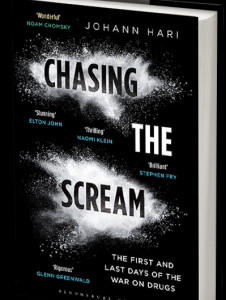




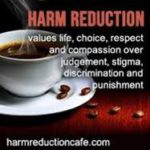 Then I started to work in harm reduction. I founded a SMART Recovery meeting, and went on to become an officer in the
Then I started to work in harm reduction. I founded a SMART Recovery meeting, and went on to become an officer in the 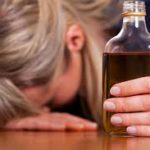 withdrawing from alcohol more times than I can count, sometimes throwing up blood for days on end and nailed to the bed in a panic attack. I didn’t even want to remember those early days of abstinence when my senses first came back and I could smell the flowers in summer and taste blueberries and coffee as though for the first time.
withdrawing from alcohol more times than I can count, sometimes throwing up blood for days on end and nailed to the bed in a panic attack. I didn’t even want to remember those early days of abstinence when my senses first came back and I could smell the flowers in summer and taste blueberries and coffee as though for the first time. After almost two years and working with countless people with substance use problems, I could feel my own pain again. And I realized something: to deny that there is a period of time when the pain is acute, and when healing has to be a priority, is to deny an essential reality of people’s lives. Of my own life. That’s when I started to use the word “recovery” again. But I do not believe that “recovery” is a permanent state. With proper self-care, support, and meaning in life, one can heal.
After almost two years and working with countless people with substance use problems, I could feel my own pain again. And I realized something: to deny that there is a period of time when the pain is acute, and when healing has to be a priority, is to deny an essential reality of people’s lives. Of my own life. That’s when I started to use the word “recovery” again. But I do not believe that “recovery” is a permanent state. With proper self-care, support, and meaning in life, one can heal. rehab, we were taught to identify as “addict” and “alcoholic,” and told that all our problems were due to our “disease.” We did little to address the issues that drove our addiction. Instead, we were taught that the answer to all problems was to attend Twelve Step meetings and work the Steps.
rehab, we were taught to identify as “addict” and “alcoholic,” and told that all our problems were due to our “disease.” We did little to address the issues that drove our addiction. Instead, we were taught that the answer to all problems was to attend Twelve Step meetings and work the Steps. As I read more, I gradually began to discover my own voice, and started to write. Reclaiming my own identity, not as an “alcoholic” but as a writer, activist and scholar was my way out, not only of addiction but of the narrow, confined life that rehab and AA had defined for me as “recovery.” And I found that my own painful experiences gave me a perspective that could help others. Today, having recovered means living a life that I don’t have to medicate away.
As I read more, I gradually began to discover my own voice, and started to write. Reclaiming my own identity, not as an “alcoholic” but as a writer, activist and scholar was my way out, not only of addiction but of the narrow, confined life that rehab and AA had defined for me as “recovery.” And I found that my own painful experiences gave me a perspective that could help others. Today, having recovered means living a life that I don’t have to medicate away. A substance is what fills up a space. The lack of substance equals, well, nothingness. When people talk about their addiction they often talk about a sense of profound emptiness, a psychological void, that gets filled by a something they can only get from what they’re addicted to. To replace a sense of nothingness with a sense of somethingness (what else to call it!) is more powerful than words like “pleasure,” “relief,” or “satisfaction” can possibly convey.
A substance is what fills up a space. The lack of substance equals, well, nothingness. When people talk about their addiction they often talk about a sense of profound emptiness, a psychological void, that gets filled by a something they can only get from what they’re addicted to. To replace a sense of nothingness with a sense of somethingness (what else to call it!) is more powerful than words like “pleasure,” “relief,” or “satisfaction” can possibly convey. Berridge has compared this urge to the desperation of a starving animal seeking food. So it may be useful to view substance and behavioural addictions as fulfilling biological needs, or at least their psychological
Berridge has compared this urge to the desperation of a starving animal seeking food. So it may be useful to view substance and behavioural addictions as fulfilling biological needs, or at least their psychological  expression. Whether we take pills, snort powder, smoke, or inject, we are putting something into our bodies. This “inputting” is a behavioural prototype. It’s primal. It’s how we eat. In the case of binge eating, the target of the behaviour makes obvious biological sense. But perhaps all behavioural addictions relate to biological needs: e.g., winning against competitors (gambling), sexual needs (obviously sex and porn addiction), even social inclusion
expression. Whether we take pills, snort powder, smoke, or inject, we are putting something into our bodies. This “inputting” is a behavioural prototype. It’s primal. It’s how we eat. In the case of binge eating, the target of the behaviour makes obvious biological sense. But perhaps all behavioural addictions relate to biological needs: e.g., winning against competitors (gambling), sexual needs (obviously sex and porn addiction), even social inclusion  (internet addiction) and resource acquisition (compulsive shopping). In my book, The Biology of Desire, I make the case that addiction serves symbolic goals. For example, the warm feeling you get from opiates symbolizes the warmth that comes from being hugged or cuddled (no small matter for us mammals).
(internet addiction) and resource acquisition (compulsive shopping). In my book, The Biology of Desire, I make the case that addiction serves symbolic goals. For example, the warm feeling you get from opiates symbolizes the warmth that comes from being hugged or cuddled (no small matter for us mammals).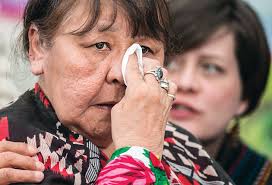 of addicts in downtown Vancouver, mostly aboriginal, mostly from foster homes, mostly abused or neglected in childhood, highlights the enormous holes in the lives of people with devastated attachment histories — holes filled by drug use.
of addicts in downtown Vancouver, mostly aboriginal, mostly from foster homes, mostly abused or neglected in childhood, highlights the enormous holes in the lives of people with devastated attachment histories — holes filled by drug use. 
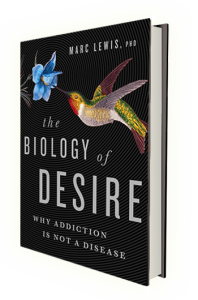 Informed by unparalleled neuroscientific insight and written with his usual flare, Marc Lewis’s The Biology of Desire effectively refutes the medical view of addiction as a brain disease. A bracing and informative corrective to the muddle that now characterizes public and professional discourse on this topic.” —Gabor Maté, M.D., author of In The Realm of Hungry Ghosts: Close Encounters With Addiction
Informed by unparalleled neuroscientific insight and written with his usual flare, Marc Lewis’s The Biology of Desire effectively refutes the medical view of addiction as a brain disease. A bracing and informative corrective to the muddle that now characterizes public and professional discourse on this topic.” —Gabor Maté, M.D., author of In The Realm of Hungry Ghosts: Close Encounters With Addiction
Recent Comments